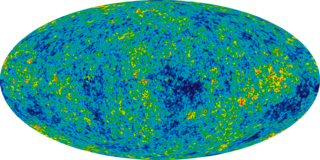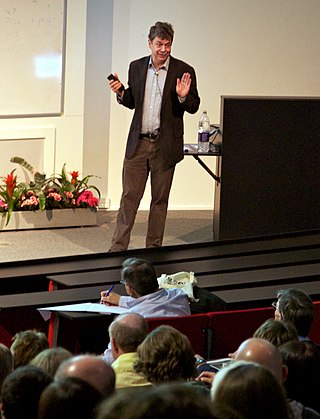
Physical cosmology is a branch of cosmology concerned with the study of cosmological models. A cosmological model, or simply cosmology, provides a description of the largest-scale structures and dynamics of the universe and allows study of fundamental questions about its origin, structure, evolution, and ultimate fate. Cosmology as a science originated with the Copernican principle, which implies that celestial bodies obey identical physical laws to those on Earth, and Newtonian mechanics, which first allowed those physical laws to be understood.

The cosmic microwave background, or relic radiation, is microwave radiation that fills all space in the observable universe. With a standard optical telescope, the background space between stars and galaxies is almost completely dark. However, a sufficiently sensitive radio telescope detects a faint background glow that is almost uniform and is not associated with any star, galaxy, or other object. This glow is strongest in the microwave region of the radio spectrum. The accidental discovery of the CMB in 1965 by American radio astronomers Arno Penzias and Robert Wilson was the culmination of work initiated in the 1940s.

The study of galaxy formation and evolution is concerned with the processes that formed a heterogeneous universe from a homogeneous beginning, the formation of the first galaxies, the way galaxies change over time, and the processes that have generated the variety of structures observed in nearby galaxies. Galaxy formation is hypothesized to occur from structure formation theories, as a result of tiny quantum fluctuations in the aftermath of the Big Bang. The simplest model in general agreement with observed phenomena is the Lambda-CDM model—that is, clustering and merging allows galaxies to accumulate mass, determining both their shape and structure. Hydrodynamics simulation, which simulates both baryons and dark matter, is widely used to study galaxy formation and evolution.
In cosmology and physics, cold dark matter (CDM) is a hypothetical type of dark matter. According to the current standard model of cosmology, Lambda-CDM model, approximately 27% of the universe is dark matter and 68% is dark energy, with only a small fraction being the ordinary baryonic matter that composes stars, planets, and living organisms. Cold refers to the fact that the dark matter moves slowly compared to the speed of light, giving it a vanishing equation of state. Dark indicates that it interacts very weakly with ordinary matter and electromagnetic radiation. Proposed candidates for CDM include weakly interacting massive particles, primordial black holes, and axions.

The Sunyaev–Zeldovich effect is the spectral distortion of the cosmic microwave background (CMB) through inverse Compton scattering by high-energy electrons in galaxy clusters, in which the low-energy CMB photons receive an average energy boost during collision with the high-energy cluster electrons. Observed distortions of the cosmic microwave background spectrum are used to detect the disturbance of density in the universe. Using the Sunyaev–Zeldovich effect, dense clusters of galaxies have been observed.

The Lambda-CDM, Lambda cold dark matter, or ΛCDM model is a mathematical model of the Big Bang theory with three major components:
- a cosmological constant, denoted by lambda (Λ), associated with dark energy
- the postulated cold dark matter, denoted by CDM
- ordinary matter

A dwarf spheroidal galaxy (dSph) is a term in astronomy applied to small, low-luminosity galaxies with very little dust and an older stellar population. They are found in the Local Group as companions to the Milky Way and as systems that are companions to the Andromeda Galaxy (M31). While similar to dwarf elliptical galaxies in appearance and properties such as little to no gas or dust or recent star formation, they are approximately spheroidal in shape and generally have lower luminosity.

In modern models of physical cosmology, a dark matter halo is a basic unit of cosmological structure. It is a hypothetical region that has decoupled from cosmic expansion and contains gravitationally bound matter. A single dark matter halo may contain multiple virialized clumps of dark matter bound together by gravity, known as subhalos. Modern cosmological models, such as ΛCDM, propose that dark matter halos and subhalos may contain galaxies. The dark matter halo of a galaxy envelops the galactic disc and extends well beyond the edge of the visible galaxy. Thought to consist of dark matter, halos have not been observed directly. Their existence is inferred through observations of their effects on the motions of stars and gas in galaxies and gravitational lensing. Dark matter halos play a key role in current models of galaxy formation and evolution. Theories that attempt to explain the nature of dark matter halos with varying degrees of success include cold dark matter (CDM), warm dark matter, and massive compact halo objects (MACHOs).
The Millennium Run, or Millennium Simulation is a computer N-body simulation used to investigate how the distribution of matter in the Universe has evolved over time, in particular, how the observed population of galaxies was formed. It is used by scientists working in physical cosmology to compare observations with theoretical predictions.

The Bullet Cluster consists of two colliding clusters of galaxies. Strictly speaking, the name Bullet Cluster refers to the smaller subcluster, moving away from the larger one. It is at a comoving radial distance of 1.141 Gpc.

Simon David Manton White, FRS, is a British-German astrophysicist. He was one of directors at the Max Planck Institute for Astrophysics before his retirement in late 2019.
The Virgo Consortium was founded in 1994 for Cosmological Supercomputer Simulations in response to the UK's High Performance Computing Initiative. Virgo developed rapidly into an international collaboration between a dozen scientists in the UK, Germany, Netherlands, Canada, United States and Japan.
Hugh Couchman is a Canadian astronomer and professor at McMaster University. He is a computational astrophysicist who studies the growth of structure in the universe via gravitational N-body simulations.
Modified Newtonian dynamics (MOND) is a theory that proposes a modification of Newton's second law to account for observed properties of galaxies. Its primary motivation is to explain galaxy rotation curves without invoking dark matter, and is one of the most well-known theories of this class. However, it has not gained widespread acceptance, with the majority of astrophysicists supporting the Lambda-CDM model as providing the better fit to observations.

Computational astrophysics refers to the methods and computing tools developed and used in astrophysics research. Like computational chemistry or computational physics, it is both a specific branch of theoretical astrophysics and an interdisciplinary field relying on computer science, mathematics, and wider physics. Computational astrophysics is most often studied through an applied mathematics or astrophysics programme at PhD level.

The Illustris project is an ongoing series of astrophysical simulations run by an international collaboration of scientists. The aim is to study the processes of galaxy formation and evolution in the universe with a comprehensive physical model. Early results were described in a number of publications following widespread press coverage. The project publicly released all data produced by the simulations in April, 2015. Key developers of the Illustris simulation have been Volker Springel and Mark Vogelsberger. The Illustris simulation framework and galaxy formation model has been used for a wide range of spin-off projects, starting with Auriga and IllustrisTNG followed by Thesan (2021), MillenniumTNG (2022) and TNG-Cluster (2023).
Tom Quinn is a professor in the Department of Astronomy at the University of Washington (UW) in Seattle. He is the leader of the N-Body Shop, a faculty member of the astrobiology program at UW, and an affiliate member at the eScience Institute. He assisted in generating the cosmological simulation code called ChaNGA.
In cosmology, Gurzadyan-Savvidy (GS) relaxation is a theory developed by Vahe Gurzadyan and George Savvidy to explain the relaxation over time of the dynamics of N-body gravitating systems such as star clusters and galaxies. Stellar systems observed in the Universe – globular clusters and elliptical galaxies – reveal their relaxed state reflected in the high degree of regularity of some of their physical characteristics such as surface luminosity, velocity dispersion, geometric shapes, etc. The basic mechanism of relaxation of stellar systems has been considered the 2-body encounters, to lead to the observed fine-grained equilibrium. The coarse-grained phase of evolution of gravitating systems is described by violent relaxation developed by Donald Lynden-Bell. The 2-body mechanism of relaxation is known in plasma physics. The difficulties with description of collective effects in N-body gravitating systems arise due to the long-range character of gravitational interaction, as distinct of plasma where due to two different signs of charges the Debye screening takes place. The 2-body relaxation mechanism e.g. for elliptical galaxies predicts around years i.e. time scales exceeding the age of the Universe. The problem of relaxation and evolution of stellar systems and the role of collective effects are studied by various techniques, see. Among the efficient methods of study of N-body gravitating systems are the numerical simulations, particularly, Sverre Aarseth's N-body codes are widely used.

Oliver Zahn is US/German theoretical astrophysicist, data scientist, and entrepreneur, best known for developing algorithms for astrophysical data analysis and widely cited discoveries of phenomena in the history of the Universe. He is also known for his more recent work as founder and CEO of Climax Foods, a California-based biotechnology company modeling dairy and other animal products directly from plant ingredients. Prior to becoming an entrepreneur, Zahn directed UC Berkeley's Center for Cosmological Physics alongside George Smoot and Saul Perlmutter and was Head of Data Science at Google








